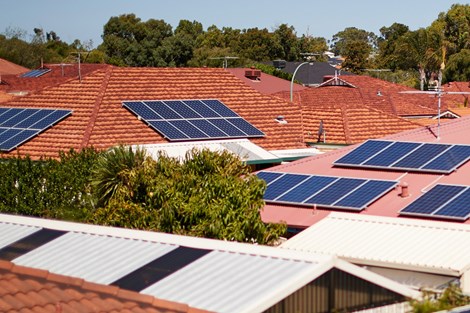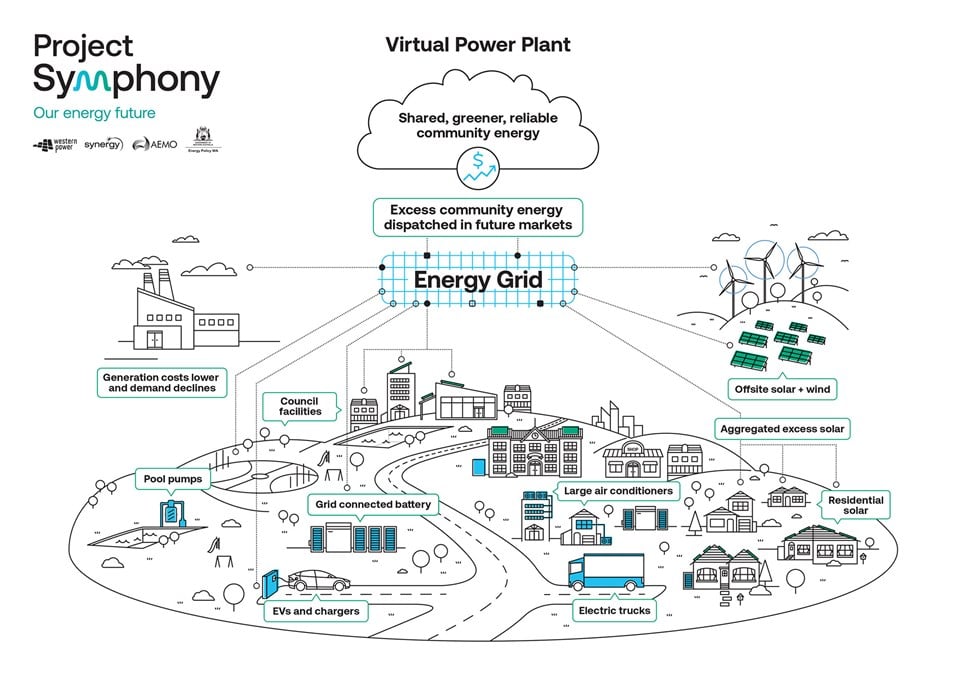Orchestrating tomorrow’s energy system today
How we generate, manage and consume energy is changing.
One in three households in Western Australia has rooftop solar, equivalent to almost 2 gigawatts of renewable energy generation. Collectively, this represents the largest source of electricity generation on the South West Interconnected System (SWIS).
Growth in consumer-owned distributed energy resources (DER), such as rooftop solar panels, in-home batteries and electric vehicles, will increase further as more solar systems with integrated battery storage come online.
However, the widespread uptake of rooftop solar creates challenges and opportunities for the delivery of electricity.
Why?
A high proportion of decentralised, unmanaged DER poses a risk to the stability of the State’s power network. This is caused by low or fluctuating energy demand at critical times.
What is Project Symphony?
Project Symphony is an innovative pilot project designed to ‘orchestrate’ approximately 900 DER assets across 500 homes and businesses in the Southern River area s of Atwell, Harrisdale and Piara Waters into a Virtual Power Plant (VPP).
The VPP aggregated the electricity generated by the DER and dispatch excess supply to the network in the same way as a traditional power plant.
Where is the Pilot happening?
The Southern River areas of Harrisdale and Piara Waters were chosen for the pilot due to the high uptake of rooftop solar - over half of all homes in the area have solar systems installed.
The VPP will help create a more stable and efficient localised electricity system with implications for the entire network.
Who are the project partners?
Project Symphony is a collaboration between Western Power, Synergy and the Australian Energy Market Operator (AEMO) to help us better understand the future design of Western Australia’s electricity system. It is an important part of the Western Australian Government's Distributed Energy Resources Roadmap, which commits to creating a cleaner, greener energy future.
Project Symphony has received support from the Australian Renewable Energy Agency (ARENA) as part of ARENA's Advanced Renewables Program.
The pilot incorporated knowledge and lessons learned from similar projects undertaken in the eastern states and overseas and applying these to the unique challenges facing the Western Australian energy system.
The views expressed herein are not necessarily the views of the Australian Government, and the Australian Government does not accept responsibility for any information or advice contained herein.
Reports
The purpose of this document is to capture the collective vision of Project Symphony, placing it in the context of the suite of Australian DER integration projects, and outline an impact pathway, particularly in the context of the Western Australian (WA) energy market, to achieve the project objectives.
Vision and Impact Pathway Report
This report provides an update on lessons learnt in the first stages of Project Symphony.
This report provides a cost benefit assessment of the economic benefits that could be provided by the operation of a virtual power plant (VPP) in Western Australia’s (WA’s) South West Interconnected System (SWIS).
This report outlines a potential set of methods for valuing services provided by resources contributing to the Project Symphony pilot only.
This report summarises the approach taken to identify and engage Third-Party Aggregators to be involved in the provision of Distributed Energy Resource (DER) services and orchestration testing within Project Symphony, and to summarise insights from primary research into customer sentiment towards DER orchestration and Third-Party Aggregators.
This report provided information on the network Distribution Constraints Optimisation Algorithm (DCOA) tool. The DCOA tool will enable the Distributed System Operator (DSO) to develop the appropriate level of distribution network constraint analysis and support the equitable deployment of Distributed Energy Resources (DER).
This report provides information about the functional and non-functional requirements for the Distributed System Operator (DSO), Distribution Market Operator (DMO) and Aggregator Platforms, to be used in an off-market pilot to simulate aggregated Distributed Energy Resource (DER) integration into the Western Australian Energy Market (WEM), as at the date of publication.
Functional and Non-Functional Requirements Report for the DMO, DSO and Aggregator
This report details the development of the Aggregator, Distribution Market Operator and Distribution System Operator and identifies methods of integrating and managing high levels of DER and enabling its technical orchestration.
Combined Platform (as built) Report for DSO, DMO and Aggregator
This report was produced by social research teams led by University of Tasmania and other research partners and forms part of a broader project examining customer responses to the Project Symphony pilot and perceptions and experiences of virtual power plants.
Project Symphony offers recommendations for policy and regulatory reforms to encourage aggregated DER participation in the WEM. It outlines an implementation pathway that improves value stream accessibility for aggregators and customers while enabling longer term development and scalability of DER orchestration.
Project Symphony’s cost-benefit analysis showed a Virtual Power Plant’s potential to deliver substantial benefits over 10 years by orchestrating DERs. Additionally, this report outlines six key recommendations to scale DER orchestration.
This report documents assesses each of Project Symphony’s work packages against a rubric that measures technology and commercial maturity. This rubric aligns with:
- A comprehensive life-cycle framework for Distributed Energy Resources (DER) integration and orchestration
- The Australian Renewable Energy Agency’s (ARENA) maturity matrices, which include technology readiness levels (TRL 1-9) and the commercial readiness index (CRI 1-6).
Project Symphony’s final report presents the 18 recommendations found whilst assessing the viability of DER orchestration. These actionable recommendations are highlighted through the framework of four ‘pillars’ - Technical, Customer, Value, and Policy & Regulation. Final Knowledge Sharing Report

